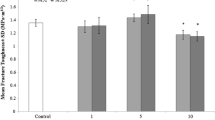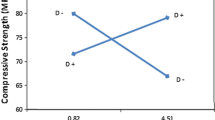Abstract
Commercial acrylic bone cements are supplied as two components, a polymer powder and a liquid monomer. Mixing of the two components is followed by a progressive polymerization of the liquid monomer to yield a solid mass, a high level of heat being generated during this exothermic reaction. The exposure of bone to high temperatures has led to incidences of bone necrosis and tissue damage, ultimately resulting in failure of the prosthetic fixation. The aim of this study was to determine the thermal properties of two acrylic bone cements as they progress through their polymerization cycles. It was also felt that there was a need to quantify the variations in the curing characteristics as a function of preparing bone cement by different techniques, hand mixing and vacuum mixing. A number of parameters were calculated using the data gathered from the investigation: peak temperature, cure temperature, cure time, and the cumulative thermal necrosis damage index. The results show the temperature profile recorded during polymerization was lowest when the cement was prepared using the Howmedica Mix-Kit I® system: 36 °C for Palacos R® and 41 °C for CMW3® respectively. When the acrylic cements were prepared in any vacuum mixing system there was evidence of an increase in the cure temperature. The main factor that contributed to this rise in temperature was an imbalance in the polymer powder : liquid monomer ratio, there was a high incidence of unmixed powder visible in the mixing barrel of some contemporary vacuum mixing devices. Observing the thermal characteristics of the polymethyl methacrylate (PMMA) bone cements assessed, it was found that particular formulations of bone cements are suited to certain mixing methodologies. It is vital that a full investigation is conducted on a cement mixing/delivery system prior to its introduction into the orthopaedic market.
Similar content being viewed by others
References
R. Feith, Acta. Orthop. Scand. Suppl. (1975) 161.
J. R. Wijn De, F. C. M. Driessens and T. J. J. H. Sloff, J. Biomaterial Res. 6 (1975) 99-103.
J. A. Dipisa, G. S. Sih and A. T. Berman, Clin. Orthop. Rel. Res. (1976) 121.
S. C. Bayne, E. P. Lautenschlager, C. L. Compere and R. Wides, J. Biomed. Mater. Res. 9(1) (1975) 27-34.
T. A. Berman, J. S. Reid, D. R. Yanicko, C. G. Sih and M. R. Zimmerman Clinical Orthopaedics and Related Research 186(1) (1984) 284-292.
G. M. Brauer, D. R. Steinberger and J. W. Stansbury, J. of Biomed. Mater. Res. 20(1) (1986) 839-852.
C. D. Jefferis, A. J. C. Lee and R. S. M. Ling, J. Bone Joint Surg. 57-B(4) (1975) 511-518.
R. Meyer, E. P. Lautenschlager and B. K. Moore, ibid. 55-A(1) (1973) 149-158.
I. C. Revie, M. E. Wallace and J. F. Orr, J. Engi. Medi. 208 (1994) 45-51.
R. Huiskes and T. J. Sloof, Trans. Orthop. Res. Soc. 6 (1981) 134.
G. C. Sih and G. M. Connelly, J. Biomech. 13(1) (1980) 347-352.
A. R. Moritz and F. C. Henriques, Am. J. Pathol. 23 (1947) 695-720.
A. R. Eriksson and T. Alberksson, J. Prosthet. Dent. 50(1) (1983) 101-107.
J. Lundskog, Scand. J. Plastic Reconstr. Surg. Suppl. (1972) 9.
B. Mjoberg, H. Petterson, R. Roseqvist and A. Rydholm, Acta. Orthop. Scand. 55 (1984) 597-600.
C. G. Nelson, E. G. Krishnan and J. R. Neff, Medical Phys. 13(4) (1986) 462-468.
S. T. Larsen, S. Franzen and L. Ryd, Acta. Orthop. Scand. 62(2) (1991) 102-105.
L. Lidgren, B. Bodelind and J. MÖller, ibid. 58(1) (1987) 27-32.
H. Seidel, A. Heggert and H. Pietsch, Arach. Orthop. Unfallchir. 90(3) (1977) 251-257.
S. S. Haas, G. M. Brauer and M. A. Dickson, J. Bone Joint Surg. 57-A(3) (1975) 380-391.
Author information
Authors and Affiliations
Rights and permissions
About this article
Cite this article
Dunne, N.J., Orr, J.F. Curing characteristics of acrylic bone cement. Journal of Materials Science: Materials in Medicine 13, 17–22 (2002). https://doi.org/10.1023/A:1013670132001
Issue Date:
DOI: https://doi.org/10.1023/A:1013670132001




